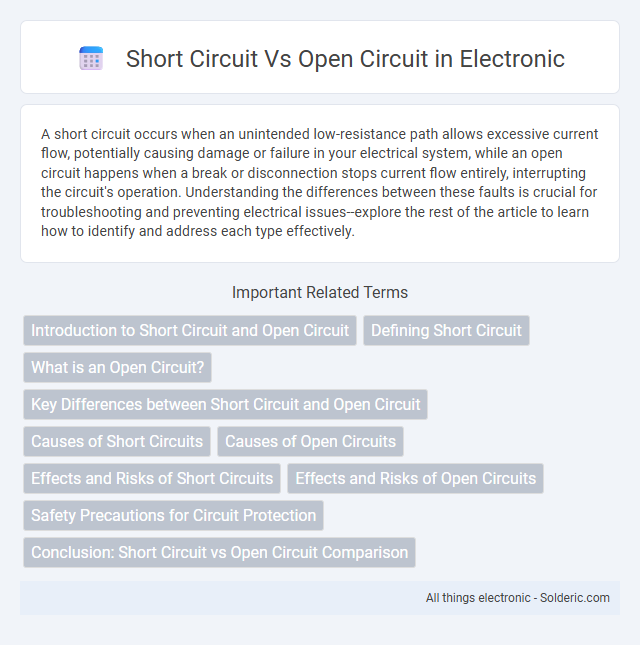A short circuit occurs when an unintended low-resistance path allows excessive current flow, potentially causing damage or failure in your electrical system, while an open circuit happens when a break or disconnection stops current flow entirely, interrupting the circuit's operation. Understanding the differences between these faults is crucial for troubleshooting and preventing electrical issues--explore the rest of the article to learn how to identify and address each type effectively.
Comparison Table
| Feature | Short Circuit | Open Circuit |
|---|---|---|
| Definition | A connection allowing current to flow via an unintended low-resistance path. | A broken or disconnected path preventing current flow. |
| Current Flow | Excessive current flow due to low resistance. | No current flow; circuit is incomplete. |
| Voltage | Voltage across the short is nearly zero. | Voltage appears across the open gap. |
| Cause | Insulation failure, wiring faults, or component damage. | Broken wires, loose connections, or damaged components. |
| Effect | Potential damage due to overheating and fire hazard. | Device or circuit stops functioning. |
| Detection | High current measurements; rapid fuse blow. | Zero current measurements; voltage present but no load. |
Introduction to Short Circuit and Open Circuit
A short circuit occurs when a low-resistance path bypasses the designed circuit, causing excessive current flow that can damage components and create safety hazards. In contrast, an open circuit happens when there is a break or disconnection in the path, preventing current from flowing and resulting in a loss of functionality. Understanding the differences between short circuits and open circuits is essential for diagnosing electrical faults and ensuring circuit reliability.
Defining Short Circuit
A short circuit occurs when an unintended low-resistance path allows excessive current to flow, bypassing the designed circuit elements. This results in potential damage to components, overheating, or electrical fires due to the sudden surge in current. In contrast, an open circuit breaks the continuity of the flow, preventing current from passing through the circuit entirely.
What is an Open Circuit?
An open circuit occurs when there is a break or gap in an electrical path, preventing current from flowing through the circuit. This interruption can be caused by a broken wire, a faulty component, or an intentionally open switch. Unlike a short circuit, which causes excessive current flow, an open circuit results in zero current flow and no power delivery to the load.
Key Differences between Short Circuit and Open Circuit
Short circuits occur when an unintended low-resistance path causes excessive current flow, potentially damaging electrical components, while open circuits happen when a break or gap in the circuit stops current flow entirely. Short circuits often result in overheating and possible fires due to the high current, whereas open circuits prevent devices from operating by interrupting the power supply. Understanding these differences helps you diagnose and troubleshoot electrical issues effectively, ensuring safety and proper function.
Causes of Short Circuits
Short circuits occur when electrical current flows along an unintended path with little or no resistance, often caused by damaged insulation, faulty wiring, or exposed wires touching each other. Overloaded circuits, loose connections, and equipment failure also contribute to the risk of short circuits. Understanding these causes helps you prevent electrical hazards and maintain safe circuit operation.
Causes of Open Circuits
Open circuits are caused primarily by broken wires, loose connections, or damaged components that interrupt the flow of electricity. Corroded terminals, burnt fuses, and disconnected cables also contribute to open circuits by preventing current from completing its path. Understanding these common causes helps you identify and troubleshoot open circuit issues effectively.
Effects and Risks of Short Circuits
Short circuits cause excessive current flow, leading to overheating, electrical fires, and damage to connected devices or wiring insulation. This sudden surge can trip circuit breakers, damage electronic components, and pose severe safety hazards including electric shock and equipment failure. Open circuits interrupt current flow, preventing operation but generally posing less risk of fire or damage compared to short circuits.
Effects and Risks of Open Circuits
Open circuits cause interruption in current flow, leading to device malfunction and loss of power. They can result in overheating of components due to improper current distribution, increasing the risk of permanent damage. Your electrical system may also experience voltage spikes, which can degrade insulation and pose safety hazards.
Safety Precautions for Circuit Protection
Short circuits create high current flow that can cause overheating, fires, or equipment damage, necessitating the use of fuses, circuit breakers, and proper insulation for protection. Open circuits prevent current flow, often signaling faults or breaks, requiring regular inspection and maintenance to ensure connections remain intact and safe. Implementing protective devices and adherence to safety standards is essential to mitigate risks associated with both short and open circuits.
Conclusion: Short Circuit vs Open Circuit Comparison
Short circuits create a low-resistance path that allows excessive current flow, potentially causing damage or fire hazards, whereas open circuits interrupt the electrical path, preventing current flow entirely. Your electrical system's safety and functionality depend on identifying and addressing these faults promptly to avoid equipment failure or hazardous conditions. Understanding the fundamental differences between short and open circuits is crucial for effective troubleshooting and system maintenance.
short circuit vs open circuit Infographic

 solderic.com
solderic.com